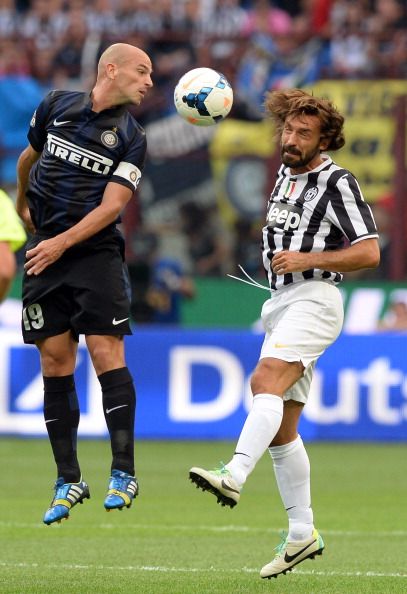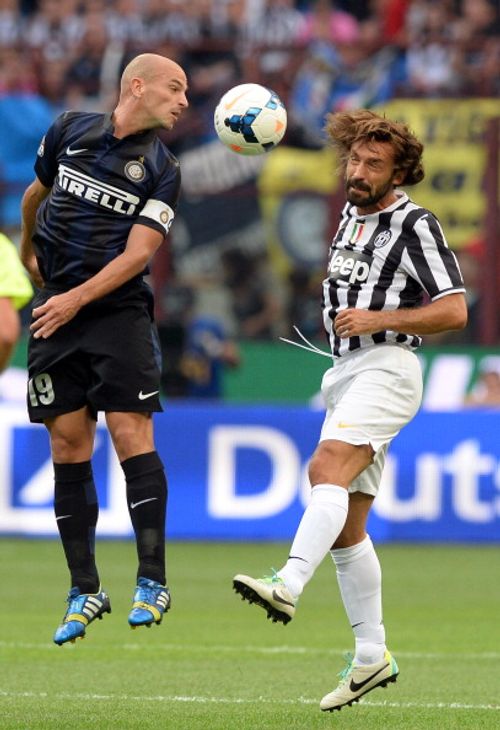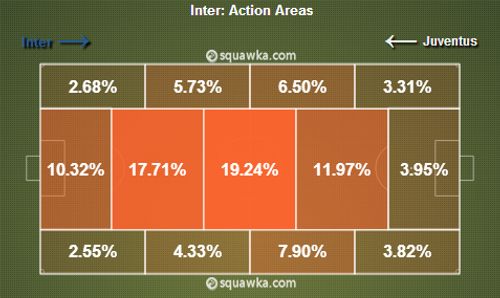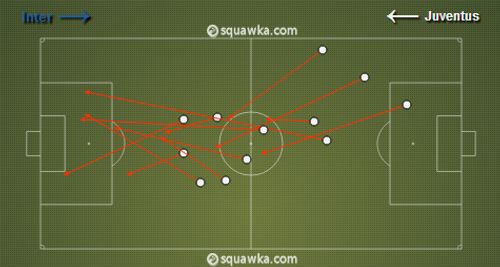
Inter 1-1 Juventus: Tactical Analysis

Andrea Pirlo of Juventus was kept in check by Esteban Cambiasso(L)
Inter and Juventus went head to head in an enthralling clash on Saturday. The Derby D’ Italia, as it is labelled, is one of the biggest football fixtures in Italy. However, a vast gulf in class has developed between the two over the past few seasons as Juventus have taken a lead of their rivals.
But the match itself is one that doesn’t disappoint. As the latest clash bears witness, it showed how Italian football has developed over the past few season, completely removing it’s ‘boring’ tag. The game was a fast paced clash, with both sides equally effective in their own rights. The gulf in class wasn’t as visible as both sides managed to hold their own. Juventus did seem to create more but Inter effectively began to soak in the pressure and use it to their advantage on the counter. The final result of Inter 1-1 Juventus seemed a fair reflection of the game as neither side managed to gain the upper hand for a prolonged period of time.
Inter’s pressing strategy
Walter Mazzarri’s men installed an effective pressing strategy, preventing Juventus from having any time on the ball. Cambiasso and Guarin were particularly hard-working in this department. It was the only method by which they could contain Juventus’ 3-man midfield of Vidal, Pirlo and Pogba; something that Lazio failed to do in the last gameweek.
The effectiveness was furthered by the understanding the Inter midfield developed. When one Inter player closed down the Juve man on the ball, another would reciprocate that by closing down his closest passing option, thus formulating an air-tight system. It was this pressing that allowed Inter in on a number of occasions, besides preventing an attack as well; it was Alvarez who quickly pounced on a rare Chiellini error to set-up Icardi’s goal.

More importantly, another factor that Inter took care of was the width provided by Lichtsteiner and Asamoah. Most often, the two wing-backs prove to be the most effective players as the opposition fail to formulate any counter measures to contain them.
However Nagatomo and Jonathan, who themselves were attempting to move forward, combined well with the central midfielders to prevent any threat from emerging. This factor of Juventus’ 3-5-2 is often the most effective and lets the rest of the system fall into place, countering that helped Inter contain them.
Gap between Midfield and Attack
This was witnessed with both sides as the final third was increasingly isolated as the game wore on. For Inter, it was a case of adopting a counter-attacking strategy, preventing much penetration from the rest of the side. They resorted to long-balls over-the-top, while otherwise quickly attempting to play direct passes into the feet of the strikers.

It left the attackers in isolation, who failed to see much of the ball. They were unable to conjure up much in terms of attack and the bulk of the game was played in midfield.
Juventus faced a similar issue; they were unable to bring their attackers into the game. An intense midfield battle was on-going, and Juve’s 3 men in the centre of the field were unable to effectively supply much. Pirlo, as usual, did create 3 chances but the rest of his midfielders failed to do so. The Juve attackers too didn’t drop deep enough, attempting to play off the shoulder of the last defender.
Both Tevez and Vucinic were tightly marked and prevented much time on the ball. Tevez, naturally did try to influence the game more by dropping deep, but was unable to get into it. Juve too were often seeing playing hopeful, rather than accurate, balls over the top and in behind the Inter defence.
The Pirlo-Cambiasso battle
The midfield battle, when further scrutinised, showcased an intense feud. The two experienced heads of their respective sides, Esteban Cambiasso and Andrea Pirlo, went head-to-head, in the centre of the park. Cambiasso was instructed to constantly keep on his midfield counterpart.
Pirlo was able to break free from his shackles, but his game was significantly disrupted. He was made to speed up on his passes, often (surprisingly) misplacing them. He, as usual, attempted the most passes on the pitch (76) but managed a pass completion rate of just 83%; something that is alien to Andrea Pirlo. This was a testament of Cambiasso’s effectiveness.

Pirlo’s failed passes, most of which were long-balls
Pirlo, in an attempt to create some time and space, often drifted into wider position, as he realised Inter’s zonal marking system would prevent Cambiasson from tracking him wide as well. Though this tactic did work, it did little in terms of the overall game, as Pirlo was unable to find the attackers with his long balls. The Inter defence won 10 aerial duels compared to the 1 won by Juve’s attackers.
Rodrigo Palacio’s fluidity
One player that caught my eye was Rodrigo Palacio. The Argentine was constantly moving, constantly attempting to find space to move into. His quick movement and pace allowed him in behind the Juve defence on a number of occasions. Juve’s defensive trio often attempt to maintain a highline, and players like Chiellini are often seen advancing forward to support the attack. This creates a void at the back and Palacio was seen attempting to take advantage.
While being efficient on the ground, he even managed to win 5 aerial duels (more than anyone on the pitch), further helping his cause. The drawback being that as the further forward, he had little in terms of support. When he did drift wide, he managed to retain possession and get past his man, but was unable to effectively take advantage of the situation. Alvares was making runs into the box and occasionally Taider did make himself available, but that wasn’t enough.